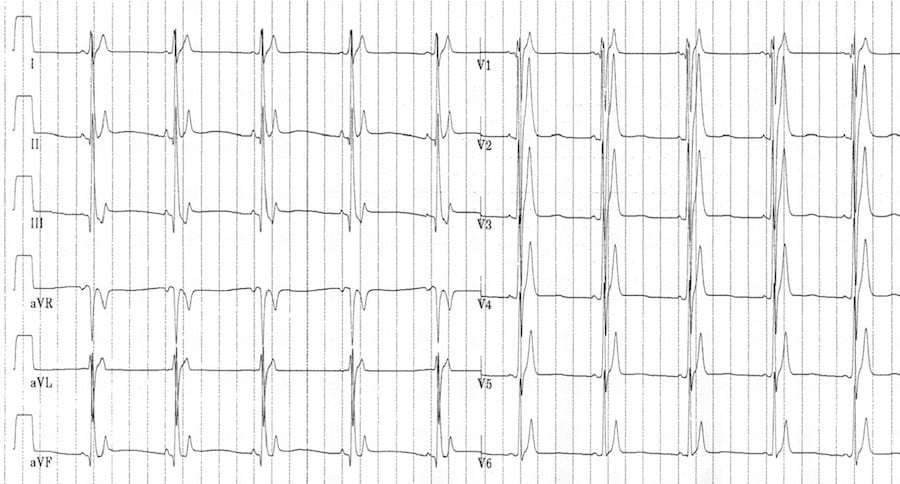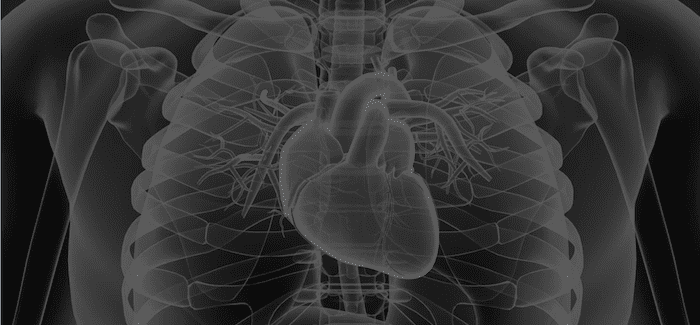Flummoxing Familial Fibrillation
aka ECG Exigency 009
An 18-year old female presents to ED with sudden onset of rapid, irregular palpitations and is found to be in fast atrial fibrillation. She denies chest pain or shortness of breath, has no significant past medical history and is not taking any prescription medications or illicit drugs.
She has an interesting family history. Her mother, brother and maternal grandfather have all suffered previous episodes of paroxysmal atrial fibrillation. She had an uncle who died of a sudden cardiac arrest at the age of 30 and a sister who died in infancy from presumed sudden infant death syndrome (SIDS).
She undergoes electrical cardioversion and successfully reverts to sinus rhythm. CXR is unremarkable. Bloods reveal normal levels of potassium, magnesium, calcium and TSH.
Her ECG looks something like this:

Questions
Q1. What are the main abnormalities on the ECG?
Answer and Interpretation
The most striking abnormalities on the ECG are:
- An extremely short QT interval (240ms at a heart rate of 65 bpm = QTc 250ms)
- Virtually absent ST segments (the end of the QRS complex merges with the start of the T wave)
- Very tall, narrow, symmetrically peaked T waves in the precordial leads
Q2. What is the likely diagnosis?
Answer and Interpretation
The combination of…
- a young patient presenting with atrial fibrillation
- a family history of paroxysmal AF
- a family history of sudden cardiac death / SIDS
- an ECG showing extremely short QT interval and peaked T waves
…suggestive of congenital short QT syndrome (SQTS)
Q3. What other conditions may cause a similar ECG appearance?
Answer and Interpretation
QT shortening on the ECG may be due to:
- Hyperkalaemia
- Hypercalcaemia
- Acidosis
- Digitalis toxicity
- Hyperthermia
- Catecholamine excess
Peaked T waves on the ECG may be due to:
- Hyperkalaemia
- Myocardial ischaemia
- Benign early repolarisation
References
- Wiesbauer F. Atrial Fibrillation Management Essentials. Medmastery
- Brugada R, Hong K, Cordeiro JM, Dumaine R. Short QT syndrome. CMAJ. 2005 Nov 22;173(11):1349-54. [PMID: 16301704]
- Crotti L, Taravelli E, Girardengo G, Schwartz PJ. Congenital short QT syndrome. Indian Pacing Electrophysiol J. 2010 Feb 1; 10(2):86-95. [PMID: 20126594]
- Gaita F, Giustetto C, Bianchi F, Wolpert C, Schimpf R, Riccardi R, Grossi S, Richiardi E, Borggrefe M. Short QT Syndrome: a familial cause of sudden death.Circulation. 2003 Aug 26;108(8):965-70. Epub 2003 Aug 18. [PMID: 12925462]
- Giustetto C, Di Monte F, Wolpert C, Borggrefe M, Schimpf R, Sbragia P, Leone G, Maury P, Anttonen O, Haissaguerre M, Gaita F. Short QT syndrome: clinical findings and diagnostic-therapeutic implications. Eur Heart J. 2006 Oct;27(20):2440-7. [PMID: 16926178] [Full text]
- Moreno-Reviriego S, Merino JL. Short QT syndrome. An article from the E-Journal of the ESC Council for Cardiology Practice. [Full text]
- Schimpf R, Wolpert C, Gaita F, Giustetto C, Borggrefe M. Short QT syndrome. Cardiovasc Res. 2005 Aug 15;67(3):357-66. [PMID: 15890322] [Full text]
- Viskin S. The QT interval: too long, too short or just right. Heart Rhythm. 2009 May;6(5):711-5. Epub 2009 Mar 3. [PMID: 19389656] [Full text]
- Hampton, JR. The ECG In Practice, 6e
- Mattu A, Brady W. ECG’s for the Emergency Physician 1
- Mattu A, Brady W. ECGs for the Emergency Physician 2
- Surawicz B, Knilans T. Chou’s Electrocardiography in Clinical Practice: Adult and Pediatric, 6e
- Wagner, GS. Marriott’s Practical Electrocardiography 12e
Further Reading
- Wiesbauer F, Kühn P. ECG Mastery: Yellow Belt online course. Understand ECG basics. Medmastery
- Wiesbauer F, Kühn P. ECG Mastery: Blue Belt online course: Become an ECG expert. Medmastery
- Kühn P, Houghton A. ECG Mastery: Black Belt Workshop. Advanced ECG interpretation. Medmastery
- Rawshani A. Clinical ECG Interpretation ECG Waves
- Smith SW. Dr Smith’s ECG blog.
- Wiesbauer F. Little Black Book of ECG Secrets. Medmastery PDF

CLINICAL CASES
ECG EXIGENCY
Emergency Physician in Prehospital and Retrieval Medicine in Sydney, Australia. He has a passion for ECG interpretation and medical education | ECG Library |
